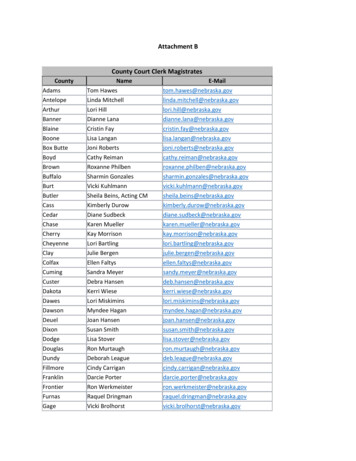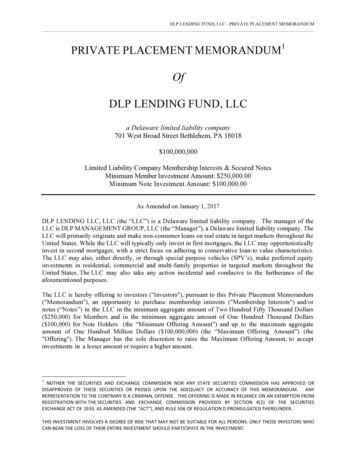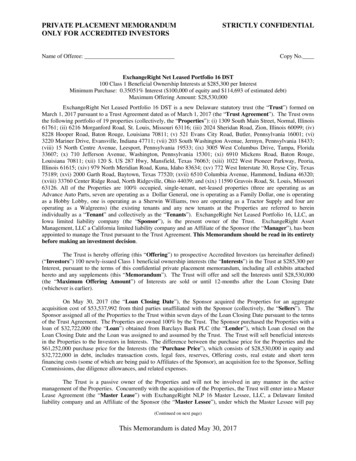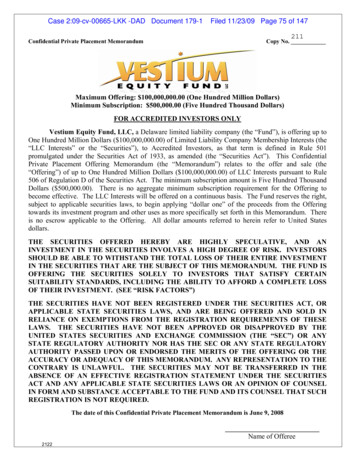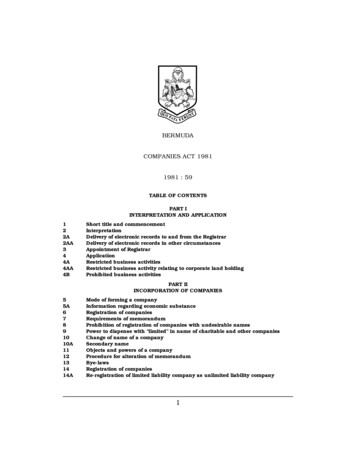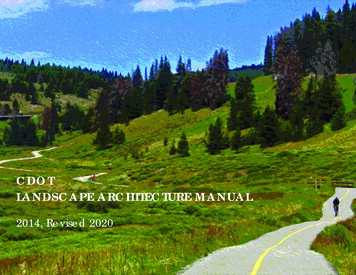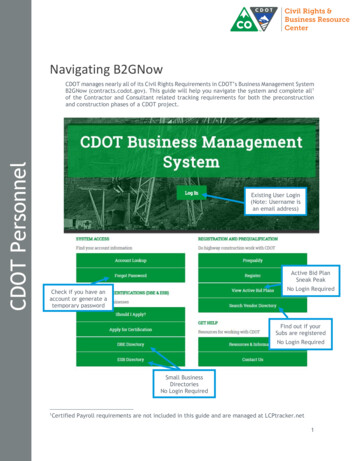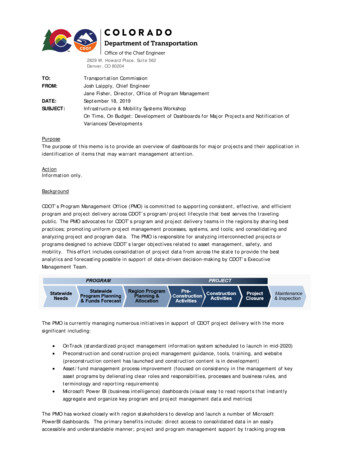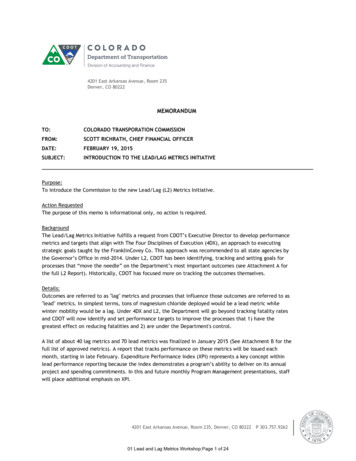
Transcription
4201 East Arkansas Avenue, Room 235Denver, CO 80222MEMORANDUMTO:COLORADO TRANSPORATION COMMISSIONFROM:SCOTT RICHRATH, CHIEF FINANCIAL OFFICERDATE:FEBRUARY 19, 2015SUBJECT:INTRODUCTION TO THE LEAD/LAG METRICS INITIATIVEPurpose:To introduce the Commission to the new Lead/Lag (L2) Metrics Initiative.Action RequestedThe purpose of this memo is informational only, no action is required.BackgroundThe Lead/Lag Metrics Initiative fulfills a request from CDOT’s Executive Director to develop performancemetrics and targets that align with The Four Disciplines of Execution (4DX), an approach to executingstrategic goals taught by the FranklinCovey Co. This approach was recommended to all state agencies bythe Governor’s Office in mid-2014. Under L2, CDOT has been identifying, tracking and setting goals forprocesses that “move the needle” on the Department’s most important outcomes (see Attachment A forthe full L2 Report). Historically, CDOT has focused more on tracking the outcomes themselves.Details:Outcomes are referred to as "lag" metrics and processes that influence those outcomes are referred to as"lead" metrics. In simplest terms, tons of magnesium chloride deployed would be a lead metric whilewinter mobility would be a lag. Under 4DX and L2, the Department will go beyond tracking fatality ratesand CDOT will now identify and set performance targets to improve the processes that 1) have thegreatest effect on reducing fatalities and 2) are under the Department's control.A list of about 40 lag metrics and 70 lead metrics was finalized in January 2015 (See Attachment B for thefull list of approved metrics). A report that tracks performance on these metrics will be issued eachmonth, starting in late February. Expenditure Performance Index (XPI) represents a key concept withinlead performance reporting because the index demonstrates a program’s ability to deliver on its annualproject and spending commitments. In this and future monthly Program Management presentations, staffwill place additional emphasis on XPI.4201 East Arkansas Avenue, Room 235, Denver, CO 80222 P 303.757.926201 Lead and Lag Metrics Workshop:Page 1 of 24
Key Benefits:L2 will mean more rigorous monitoring and goal setting for processes that drive results on theDepartment’s top outcomes.Next Steps:Following 4DX, CDOT will develop a “cadence of accountability” by holding monthly performance reviewsfor metrics published in the monthly report. These sessions will be led by the Chief Financial Officer withparticipation from program managers, the Division of Transportation Development, Division of Accounting& Finance, and others. A subset of metrics in the report will be reviewed at each meeting, with the goalof reviewing all metrics once each quarter. Executive Managers and supporting staff responsible for eachmetric will be on hand to provide data, context and—when needed—steps for course correction.Attachments:Attachment A: L2 ReportAttachment B: CDOT Lead and Lag Project Performance Metrics February 6, 20154201 East Arkansas Avenue, Room 235, Denver, CO 80222 P 303.757.926201 Lead and Lag Metrics Workshop:Page 2 of 24
REPORTAttachment AL2 (Lead/Lag Metrics) Report01 Lead and Lag Metrics Workshop:Page 3 of 24Colorado Department of TransportationTransportation Performance BranchDraft date: Jan. 3, 2015
ContentsI. Safety 2II. Infrastructure Condition 4III. System Performance 7IV. Highway Freight Movement 10V. Environmental Stewardship 12VI. Reduced Project-Delivery Delays 13VII. Transit/Multimodal 15VIII. Business Excellence 17KeyCommon abbreviations in this report include:CY Goal tracked on a calendar‐year basis.FY Goal tracked on a state fiscal‐year basis.FFY Goal tracked on a federal fiscal‐year basis.FFYS Goal tracked on a seasonal basis.M Performance reported on a monthly basis.Interstate 25 at 6th Avenue, Oct. 28., 2014.Q Performance reported on a quarterly basis.A Performance reported on an annual basis.01 Lead and Lag Metrics Workshop:Page 4 of 241
I. Safety(1/2)GOALReduce traffic fatalities andserous injuries and worktoward zero deaths for allusers.LAG MEASURESCYSMT Member:Ryan Rice/Darrell LingkM Achieve an average annualreduction of 12 fatalities, startingfrom a base of 548 in 2008.There were 481 fatalities in2013*, and the target for 2015 is464. Achieve an average annualreduction of 2.5 percent infatalities per 100 million vehiclemiles traveled (VMT), startingfrom a base year of 2013. Therewere 1.03 fatalities per 100million VMT* in 2013, and the2015 target is 0.97. Achieve an average annualreduction of 90 serious injuries,starting from a base year of2013. There were 3,200 seriousinjuries in 2013, and the 2015target is 3,020. Achieve an average annualreduction of 2.9 percent inserious injuries per 100 millionvehicle miles traveled (VMT)compared to the base year of2013. There were 6.86 seriousinjuries per 100 million VMT in2013, and the 2015 target is6.47.LEAD MEASURE 1. SMT Member: Ryan RiceCYMAchieve an Expenditure Performance Index (XPI) value of 1.0 for theFASTER Safety mitigation program for calendar year 2015.LEAD MEASURE 2. SMT Member: Ryan RiceCYMAchieve an Expenditure Performance Index (XPI) value of 1.0 for theHighway Safety Improvement Program (HSIP) for calendar year 2015.LEAD MEASURE 3. SMT Member: Ryan RiceCYMAchieve an average benefit/cost ratio (B/C) of at least 2.0 for HighwaySafety Improvement Program (HSIP) projects advertised for calendaryear 2015. A B/C of 1.6 was achieved in Q3 CY14.LEAD MEASURE 4. SMT Member: Ryan RiceCYMFor FASTER Safety projects that go to ad during each month, increasethe percentage that address Level of Safety Service (LOSS) 3 and LOSS 4locations to at least 90 percent for calendar year 2015. Seventy‐onepercent of projects addressed such locations in Q3 CY14.*2013 numbers are still unofficial per federal regulations.01 Lead and Lag Metrics Workshop:Page 5 of 242
I. Safety(2/2)GOALReduce traffic fatalities andserous injuries and worktoward zero deaths for allusers.LAG MEASURESCYSMT Member:Ryan Rice/Darrell Lingk M Achieve an average annualreduction of 12 fatalities, startingfrom a base of 548 in 2008.There were 481 fatalities in2013*, and the target for 2015 is464. Achieve an average annualreduction of 2.5 percent infatalities per 100 million vehiclemiles traveled (VMT), startingfrom a base year of 2013. Therewere 1.03 fatalities per 100million VMT* in 2013, and the2015 target is 0.97. Achieve an average annualreduction of 90 serious injuries,starting from a base year of2013. There were 3,200 seriousinjuries in 2013, and the 2015target is 3,020. Achieve an average annualreduction of 2.9 percent inserious injuries per 100 millionvehicle miles traveled (VMT)compared to the base year of2013. There were 6.86 seriousinjuries per 100 million VMT in2013, and the 2015 target is6.47.LEAD MEASURE 5. SMT Member: Darrell LingkCYMAchieve 65,000 dedicated law enforcement contact hours for trafficsafety enforcement (speed, impaired driving, seat belt, etc.) forcalendar year 2015. Dedicated law enforcement contact hours refer tothe time spent by law enforcement conducting traffic law enforcementactivities while using dedicated state funds or federal grant funds forimpaired driving, speed, seat belt, high visibility enforcement, etc.LEAD MEASURE 6. SMT Member: Josh LaipplyCYMAchieve an Expenditure Performance Index (XPI) value of 1.0 for therockfall mitigation program for calendar year 2015.LEAD MEASURE 7. SMT Member: Darrell LingkCYMAchieve an Expenditure Performance Index (XPI) value of 1.0 forestimated National Highway Traffic Safety Administration (NHTSA) grantfunds for calendar year 2015.*2013 numbers are still unofficial per federal regulations.01 Lead and Lag Metrics Workshop:Page 6 of 243
II. InfrastructureCondition (1/3)FYLEAD MEASURE 1. SMT Member: Josh LaipplyLAG MEASURE FYSMT Member:Josh LaipplyGOALPreserve the transportationinfrastructure condition to ensuresafety and mobility at a least life‐cycle cost.AAchieve high/moderateDrivability Life for 76percent of state highwaysystem pavement forfiscal year 2015.* Infiscal year 2014, 73percent of state highwaypavement hadhigh/moderateDrivability Life.FYMAchieve at least an 80 percent match between Surface Treatmentprogram projects advertised for fiscal year 2015 andrecommendations made from the pavement managementsystem. (Sixty‐seven percent of advertised projects were a matchas of Dec. 31, 2014.) This measure ensures actual constructionprojects are matching the pavement models that are designed toensure CDOT achieves the desired Drivability Life.LEAD MEASURE 2. SMT Member: Josh Laipply CY MAchieve an Expenditure Performance Index (XPI) value of 1.0 forthe Surface Treatment program for calendar year 2015. As ofNovember, the year‐to‐date XPI value for 2014 was 1.16. Thespending target for each calendar year (e.g., CY15) will equal theprogram budget for the fiscal year that ends June 30 of that year(e.g., FY15).*This goal may be revised with new predictive analyses from the SurfaceTreatment program in January 2015.01 Lead and Lag Metrics Workshop:Page 7 of 244
II. InfrastructureCondition (2/3)LEAD MEASURE 1. SMT Member: Kyle LesterFY MAchieve at least an 80 percent match for January 2015 throughJune 2015 between recommendations made by the pavementmanagement system and expended Maintenance Resurfacingprojects of 50,000 or more.LAG MEASURE FYGOALPreserve the transportationinfrastructure condition to ensuresafety and mobility at a least life‐cyclecost.SMT Member:Kyle LesterAAchieve an overallMaintenance Levels ofService grade of “B‐" forthe state highway systemfor fiscal year 2015.LEAD MEASURE 2. SMT Member: Kyle LesterFYMAchieve a minimum retro‐reflectivity for long‐line striping of80 mcd/m²/lux for fiscal year 2015. Reliability of monthlysamples, which are taken at random locations, will beconfirmed via system‐wide measurement in April and June.LEAD MEASURE 3. SMT Member: Kyle LesterSMAchieve a “B” grade for level of service for snow‐and‐icecontrol on the state highway system for 80 percent of stormevents from Jan. 1, 2015 until May 31, 2015. (The snow‐and‐ice control grade was not previously tracked by storm event.CDOT achieved a “B” for overall snow‐and‐ice control in fiscalyear 2014.)LEAD MEASURE 4. SMT Member: Kyle LesterFY MReduce the number of overdue repair findings on majorstructures from 74 in December 2014 to 62 by June 30, 2015.01 Lead and Lag Metrics Workshop:Page 8 of 245
II. InfrastructureCondition (3/3)LEAD MEASURE 1. SMT Member: Josh LaipplyLAG MEASURE FYGOALPreserve the transportationinfrastructure condition toensure safety and mobility at aleast life‐cycle cost.SMT Member:Josh LaipplyAMaintain the percentageof state highway bridge‐deck area that is NotStructurally Deficient ator above 90 percenteach fiscal year. (94percent of deck area wasNot Structurally Deficientin fiscal year 2014.)CY MAchieve an Expenditure Performance Index (XPI) value of 1.0 for the On‐System Bridge program for calendar year 2015. As of November, the year‐to‐date XPI value for 2014 was 0.83. The spending target for the calendaryear (e.g., CY15) will equal the program budget for the fiscal year that endsJune 30 of that year (e.g., FY15).LEAD MEASURE 2. SMT Member: Josh LaipplyCY MAchieve an Expenditure Performance Index (XPI) value of 1.0 for theColorado Bridge Enterprise for calendar year 2015. As of November, theyear‐to‐date XPI value for 2014 was 0.52. The spending target for thecalendar year (e.g., CY15) will equal the program budget for the fiscal yearthat ends June 30 of that year (e.g., FY15).01 Lead and Lag Metrics Workshop:Page 9 of 246
III. SystemPerformance(1/3)I‐70 WINTER LAG MEASURE SSMT Member: Ryan RiceSMT Member: Ryan RiceGOALImprove system reliability andreduce congestion, primarilythrough operationalimprovements and secondarilythrough the addition ofcapacity.MI‐70 WINTER LAG MEASURESMClear 80 percent of reported blocked lanes with CourtesyPatrol on eastbound Interstate 70 (Vail to Idaho Springs MP242) on Sundays during winter 2014‐15.LEAD MEASURE 3. SMT Member: Kyle Lester SMAchieve a B level of service for snow‐and‐ice control onInterstate 70 (Vail to C‐470) for 100 percent of storm eventsfor Jan. 1, 2015 to May 31, 2015.MReduce closure time on eastboundInterstate 70 (Vail to C‐470) from 335hours in winter 2013‐14 to 268 hours inwinter 2014‐15.Notes:‐‐Winter is the period of October 1st to May 31stSummer is the period of Memorial Day weekend(Friday) through Labor Day weekend (Monday).‐‐Planning Time Index represents the 95thpercentile travel time divided by free‐flow time.According to the Federal HighwayAdministration, a “planning time indexrepresents how much total time a travelershould allow to ensure on‐timearrival For example, a planning time index of1.60 means that for a trip that takes 15 minutesin light traffic a traveler should budget a total of24 minutes to ensure on‐time arrival 95 percentof the time. “LEAD MEASURE 2. SMT Member: Ryan Rice SSReduce number of days with delays ofmore than 90 minutes on eastbound I‐70(Vail to C‐470) from four days in winter2013‐14 to zero days in winter 2014‐15.SMT Member: Ryan RiceMAchieve average clearance time (notification to lane cleared)for Heavy Tow program on eastbound Interstate 70 (Vail to C‐470) from 18:05 minutes for winter 2013‐14 to 16:00minutes for winter 2014‐15.Decrease the Planning Time Index foreastbound Interstate 70 (Vail to C‐470)from 2.2 in winter 2013‐14 to 1.95 inwinter 2014‐15.I‐70 WINTER LAG MEASURELEAD MEASURE 1. SMT Member: Ryan Rice SMSLEAD MEASURE 4. SMT Member: Kyle LesterMDecrease the downtime of essential equipment (e.g.,tandems, mid‐ranges, signal trucks) to less than 20 percentfrom Dec. 1, 2014, to May 31, 2015.I‐70 SUMMER LAG MEASURE SSMT Member: Ryan RiceLEAD MEASUREMReduce the Planning Time Index foreastbound Interstate 70 (from Vail to C‐470, summer months) on Sundays from2.4 in summer 2014 to 2.0 by Sept. 6,2015.SMT Member: Ryan RiceSMClear 80 percent of reported blocked lanes with CourtesyPatrol on eastbound Interstate 70 (Vail to Idaho Springs MP242, summer months) on Sundays during summer 2015.01 Lead and Lag Metrics Workshop:Page 10 of 247
III. SystemPerformance(2/3)I‐25 SOUTHBOUND LAG MEASURE CYSMT Member: Ryan RiceGOALImprove system reliability andreduce congestion, primarilythrough operationalimprovements and secondarilythrough the addition ofcapacity. Support opportunitiesfor mode choice.MReduce the Planning Time Index forsouthbound Interstate 25 (from Interstate70 to Colorado Boulevard) during peakhours (Monday‐Friday, 7 a.m. to 9 a.m.and 4 p.m. to 6 p.m.). Reduce morning times PTI fromJanuary‐July 2014* performance of 3.53to 3.00 for calendar year 2015.LEAD MEASURE 1. SMT Member: Ryan RiceCY MClear 80 percent of reported blocked lanes with CourtesyPatrol on southbound Interstate 25 (I‐70 to ColoradoBoulevard) when Courtesy Patrol during peak hours.LEAD MEASURE 2. SMT Member: Kyle LesterSMAchieve a “B ” level of service for snow‐and‐ice control onsouthbound Interstate 25 for 100 percent of storm events (I‐70 to Colorado Boulevard) from Jan. 1, 2015 to May 31,2015. Reduce evening times PTI from January‐July 2014* performance of 3.72 to 3.16for calendar year 2015.LEAD MEASURE 3. SMT Member: Ryan Rice*2014 data will be updated in January2015.Increase the percentage of entrance ramps with ramp meterson southbound Interstate 25 (from I‐70 to ColoradoBoulevard) from 35 percent (5 of 14 ramps) in 2014 to 57percent (8 of 14 ramps) by Dec. 31, 2015.01 Lead and Lag Metrics Workshop:Page 11 of 24CY M8
III. SystemPerformance(3/3)GOALImprove system reliability andreduce congestion, primarilythrough operationalimprovements and secondarilythrough the addition ofcapacity. Support opportunitiesfor mode choice.I‐25 NORTHBOUND LAG MEASURE CYSMT Member: Ryan RiceMReduce the Planning Time Index fornorthbound Interstate 25 (from ColoradoBoulevard to I‐70) during peak eveninghours from 4.52 for January‐July 2014* to3.60 for calendar year 2015.Evening peak hours are Monday‐Friday, 4p.m. to 6 p.m. A metric for morning peakhour PTI is not included, because it isalready relatively low (2.00).SMT Member: Debra Perkins‐SmithClear 80 percent of reported blocked lanes with CourtesyPatrol on northbound Interstate 25 (Colorado Boulevard to I‐70) during evening peak hours.LEAD MEASURE 2. SMT Member: Kyle Lester SMAchieve a “B ” level of service for snow‐and‐ice control onInterstate 25 (Colorado Boulevard to I‐70) for 100 percent ofstorm events from Jan. 1, 2015 to May 31, 2015.LEAD MEASURE 3. SMT Member: Ryan Rice CY MIncrease the percentage of entrance ramps on northboundInterstate 25 (from Colorado Boulevard to I‐70) with rampmeters from 13 percent (2 of 15 ramps) in 2014 to 20percent (3 of 15) by Dec. 31, 2015.*2014 data will be updated in January2015.FUTURE LAG MEASURELEAD MEASURE 1. SMT Member: Ryan Rice CY MCYATravel‐Time Index for congested corridorson the state highway system. This metricwill be fully developed by June 30, 2015.FUTURE LEAD MEASURE. SMT Member: Ryan Rice CY MThis metric will be developed by June 30, 2015.01 Lead and Lag Metrics Workshop:Page 12 of 249
IV. HighwayFreightMovement(1/2)LEAD MEASURE 1. SMT Member: Ryan RiceCYMClear 80 percent of reported blocked lanes with Courtesy Patrol onsouthbound Interstate 25 (I‐70 to Colorado Boulevard) for calendaryear 2015 when Courtesy Patrol is on duty.I‐25 SOUTHBOUNDLAG MEASURESMT Member: Rice/Perkins‐SmithCYAReduce the Travel‐Time Index ofon southbound Interstate 25(from Interstate 70 to ColoradoBlvd.) on Sundays from 1.39 for2014 YTD to 1.25 by Dec. 31,2015.GOALImprove mobility on the freightnetwork to enhance freightmovement and to supporteconomic competitiveness.LEAD MEASURE 2. SMT Member: Kyle LesterSMT Member: Rice/Perkins‐SmithReduce the Travel‐Time Indexon northbound Interstate 25(from Colorado Blvd. toInterstate 70) from 1.64 for2014 YTD to 1.47 by Dec. 31,2015.CYMAchieve a B level of service for snow‐and‐ice control on southboundInterstate 25 (I‐70 to Colorado Boulevard) for 100 percent of stormevents from Jan. 1, 2015 to May 31, 2015.LEAD MEASURE 3. SMT Member: Ryan RiceCYMIncrease the percentage of entrance ramps with ramp meters onsouthbound Interstate 25 (from I‐70 to Colorado Boulevard) from 35percent (5 of 14 ramps) in 2014 to 57 percent (8 of 14 ramps) by Dec.31, 2015.LEAD MEASURE 1. SMT Member: Ryan RiceI‐25 NORTHBOUNDLAG MEASURESCYMClear 80 percent of reported blocked lanes with Courtesy Patrol onnorthbound Interstate 25 (from Colorado Boulevard to I‐70) duringevening peak hours.ALEAD MEASURE 2. SMT Member: Kyle LesterSMAchieve a “B ” level of service for snow‐and‐ice control onnorthbound Interstate 25 (from Colorado Blvd to I‐70) for 100 percentof storm events from Jan. 1, 2015 to May 31, 2015.LEAD MEASURE 3. SMT Member: Ryan RiceCYMIncrease the percentage of entrance ramps on northbound Interstate25 (from Colorado Boulevard to I‐70) with ramp meters from 13percent (2 of 15 ramps) in 2014 to 20 percent (3 of 15) by Dec. 31,2015.01 Lead and Lag Metrics Workshop:Page 13 of 2410
IV. HighwayFreightMovement(2/2)GOALImprove mobility on the freightnetwork to enhance freightmovement and to supporteconomic competitiveness.CYFUTURE LAG MEASURESMT Member: Debra Perkins‐SmithALag metrics for the following critical freight corridors willbe developed by June 30, 2015:1. North Interstate 25 SB and NB, from Interstate 70 toState Highway 66. (Consider effects from express tolllane.)2. Interstate 25 South from US 24 to Baptist Rd.3. Interstate 70 from C‐470 to Pena Blvd.4. Interstate 76 From I‐70 to US 85.Critical freight corridors are roadways with the highestvolume of commercial vehicle traffic and significantbottlenecks.FUTURE LAG MEASURESMT Member: Debra Perkins‐SmithCY MSMT Members: R. Rice, D. Perkins‐SmithFUTURE LEAD MEASURETBD by June 30, 2015.CYFUTURE LEAD MEASUREAReduce truck crashes in identifiedCommercial Motor Vehicle crash hotspots from X in calendar year 2015 to Y incalendar year 2016. Metric to be finalizedby June 30, 2015.SMT Members: R. Rice, D. Perkins‐SmithCYAAddress two identified Commercial Motor Vehicle crash hotspots per calendar year. Program to address such hot spotsto be developed by June 30, 2015. Year 1 implementation tobe completed by December 201601 Lead and Lag Metrics Workshop:Page 14 of 2411
V. EnvironmentalStewardshipLEAD MEASURE 1SMT Member: Debra Perkins‐SmithLAG MEASUREGOALEnhance the performance of thetransportation system whileminimizing the impact to andencouraging the preservation ofthe environment.FYSMT Member:Debra Perkins‐Smith MMaintain zeroenvironmental notices ofviolation/enforcementactions (to CDOT) fromstate and federalenvironmental regulatoryagencies.FYMIncrease the percentage of construction storm‐waterinspection findings responded to within 48 hours from 91percent in FY14 to 93 percent in FY15. The FY16 target is 94percent.LEAD MEASURE 2SMT Member: Debra Perkins‐SmithFYMFor FY15 and FY16, train* 720 people per year in water‐quality issues.Training includes the Transportation Erosion Control Supervisor (TECS) Program;Maintenance Transportation Erosion Control Supervisor (MTECS) Program; BestManagement Practices (BMP) Selection; Storm Water Management Plan (SMWP) I and II;STIC CDOT Revegetation Training; Maintenance Permanent Control Measures (MPCM)Training; Water Quality Permits and Regulations for the Transportation Professional;Conducting Storm Water Compliance Inspections for Construction Activities; ConductingStorm Water Compliance Inspections for Maintenance Personnel; Landscape Design modulefor Transportation Engineering Training Program (TETP); and Introduction to Water Qualityfor New Employees.01 Lead and Lag Metrics Workshop:Page 15 of 2412
VI. ReducedProject‐DeliveryDelays 1/2GOALReduce project costs, promotejobs and the economy, andexpedite the movement ofpeople and goods byaccelerating project completionthrough eliminating delays inthe project development anddelivery process. This includesimproving CDOT’s workpractices.LEAD MEASURE 1. SMT Member: Josh LaipplyCY MAchieve an Expenditure Performance Index (XPI) value of 1.0for construction program spending for calendar year 2015. Asof December, the year‐to‐date XPI value for 2014 was 0.74.LEAD MEASURE 2. SMT Member: Josh LaipplyLAG MEASURESMT Member: Josh LaipplyCYQExpend 100 percent of plannedconstruction program dollars byDecember 31 following the close ofthe fiscal year. CDOT will be trackingthis measure for Q4 CY14, with firstresults available in January 2015.CY MAchieve an Expenditure Performance Index (XPI) value of 1.0for the Surface Treatment program for calendar year 2015. Asof November, the year‐to‐date XPI value for 2014 was 1.16.The spending target for each calendar year (e.g., CY15) willequal the program budget for the fiscal year that ends June30 of that year (e.g., FY15).LEAD MEASURE 3. SMT Member: Josh LaipplyCY MAchieve an Expenditure Performance Index (XPI) value of 1.0for the On‐System Bridge program for calendar year 2015. Asof November, the year‐to‐date XPI value for 2014 was 0.83.The spending target for the calendar year (e.g., CY15) willequal the program budget for the fiscal year that ends June30 of that year (e.g., FY15).LEAD MEASURE 4. SMT Member: Josh LaipplyCYMAchieve an Expenditure Performance Index (XPI) value for theColorado Bridge Enterprise of 1.00 for calendar year 2015. Asof November, the year‐to‐date XPI value for 2014 was 0.52.The spending target for the calendar year (e.g., CY15) willequal the program budget for the fiscal year that ends June30 of that year (e.g., FY15).LEAD MEASURE 5. SMT Member: Josh LaipplyCY MAchieve a Schedule Performance Index (SPI) value of 0.9 forRAMP Partnership and Operations projects each month incalendar year 2015.01 Lead and Lag Metrics Workshop:Page 16 of 2413
VI. Reduced Project‐Delivery Delays 2/2LEAD MEASURE 6CYSMT Member: Josh LaipplyCYMAchieve an Expenditure Performance Index (XPI) value of 1.0for the Regional Priority Program (RPP) for calendar year2015.LEAD MEASURE 7LAG MEASURESMT Member: Josh LaipplyGOALReduce project costs, promotejobs and the economy, andexpedite the movement ofpeople and goods byaccelerating project completionthrough eliminating delays inthe project development anddelivery process. This includesimproving CDOT’s workpractices.SMT Member: Josh LaipplyCY MExpend 100 percent of plannedconstruction program dollars byCYDecember 31 following the close of thefiscal year. We will be tracking thismeasure for Q4 CY14, with first resultsavailable in January 2015.CYMAchieve an Expenditure Performance Index (XPI) value of 1.0for the FASTER Safety mitigation program for calendar year2015.LEAD MEASURE 8SMT Member: Josh LaipplyCYMAchieve an Expenditure Performance Index (XPI) value of 1.0for the Highway Safety Improvement Program (HSIP) forcalendar year 2015.FUTURE LEAD MEASURE SMT Member: Josh Laipply CY MAchieve a Schedule Performance Index value of 0.9 for thecurrent year’s construction program each month in calendaryear 2015. Reporting to begin April 1, 2015.LAG MEASURESMT Member: Josh LaipplyLEAD MEASURECY MCYEnsure that no more than 2 percent oflocal agency projects are inactive by Dec.31, 2015.SMT Member: Josh LaipplyCYMNotify at the start of each month the Local Agency (LA)contact at all Local Agencies with inactive projects.01 Lead and Lag Metrics Workshop:Page 17 of 2414
VII. Transit/Multimodal(1/2)LAG MEASUREImprove mobility and accessthrough transit and othertransportation modes. Maintainthe transit fleet in a state ofgood repair.ASMT Member: Mark ImhoffLEAD MEASUREMaintain the percentage of vehicles in therural Colorado transit fleet to no less than65 percent operating in fair, good orexcellent condition, per Federal TransitAdministration definitions. (Data availableJanuary 2015).SMT Member: Mark ImhoffLAG MEASUREGOALCYSMT Member: Mark ImhoffCYFUTURE LEAD MEASURESMT Member: Mark ImhoffLEAD MEASURESMT Member: Mark ImhoffCY MEnsure that Bustang operators perform 100 percent ofrecommended preventive maintenance inspections androutine repair in calendar year 2015 within 600 miles of thecontractually indicated intervals.LEAD MEASUREFY MMReduce turnaround time for 85 percent oftransit operating grant invoices to a three‐month rolling average of 45 days by June30, 2016. Tracking to begin in April 2015.MIncrease the percent of grant partners with completed assetmanagement plans from 20 percent (14 of 70) as ofDecember 2014 to 35 percent (25 of 70) by December 2015.AEnsure that 100 percent of theInterregional Express (Bustang) fleet is ingood to excellent condition, per FederalTransit Administration definitions,throughout calendar year 2015.CYSMT Member: Mark ImhoffFYMObtain Colorado Association of Transit Agencies (CASTA)board approval of CDOT’s revised invoicing reimbursementprocedures for transit operating grants by June 30, 2015.01 Lead and Lag Metrics Workshop:Page 18 of 2415
VII. Transit/Multimodal(2/2)LEAD MEASURE 1SMT Member: Mark ImhoffLAG MEASURESMT Member: Mark ImhoffCYMCY MEnsure that 100 percent of origin pick‐up timesare zero minutes early to 10 minutes afterscheduled times in calendar year 2015.Achieve Bustang fare box recovery rate ofat least 20 percent by Dec. 31, 2015.FUTURE LEAD MEASURESMT Member: Mark ImhoffCY MMetric related to custodial/cleanlinessperformance of Bustang contractors. Metric willbe established by Jan. 31, 2015, and trackingwill begin when the Bustang service beginsoperations.GOALImprove mobility and accessthrough transit and othertransportation modes. Maintainthe transit fleet in a state ofgood repair.FUTURE LAG MEASURE FY ASMT Member: Mark ImhoffA metric related to populations connectedby Bustang or Bustang ridership per capitawill be established by June 30, 2015.Metric will include a goal for June 30,2016.01 Lead and Lag Metrics Workshop:Page 19 of 24FUTURE LEAD MEASURESMT Member: Mark ImhoffFY MMetric will be established by June 30, 2015, witha goal for June 30, 2016.16
VIII.BusinessExcellence(1/4)GOALPromote efficiency andexcellence in workforcedevelopment and department‐wide business practices.LAG MEASURECYLEAD MEASURE 1. SMT Member: Richrath/Laipply CY MMReduce cash balance from 1.40 billion inJune 2014 to 710 million by Dec. 31,2015.Increase work under contract from 582 million in November2014 to 1.0 billion by March 31, 2015. Maintain at 1.0billion every March 31 through 2017. Work Under Contract isthe remaining contract value in contracts under which atleast 1 has been spent.LAG MEASURECYLEAD MEASURE 2. SMT Member: Richrath/Laipply CY MMAchieve an Expenditure Performance Index (XPI) value of 1.0for construction program spending for calendar year 2015. Asof December, the year‐to‐date XPI value for 2014 was 0.74.SMT Member: Scott RichrathSMT Member: Scott RichrathReduce cash balance/cash equivalentsfrom 1.83 billion in June 2014 to 1.13billion by Dec. 31, 2015.LAG MEASURESMT Member: Heidi HumphreysFYMDecrease the time from Personnel ChangeRequest (PCR) to employee start datefrom an average of 82 days in fiscal year2014 to an average of 78 days by June 30,2015.LAG MEASURESMT Member: Heidi HumphreysFYMDecrease the average number of daysfrom Personnel Change Request (PCR) toReferral from 46 days in fiscal year 2014to 44 days by June 30, 2015.LEAD MEASURESMT Member: Heidi HumphreysFY MIncrease from zero percent to 90 percent by June 30, 2015,the percentage of Appointing Authorities, Superintendentsand PEIII’s who have participated in training engagements oncompleting a Personnel Change Request (PCR) andstreamlining the process from referral to start date. Note:This includes training on required timelines and relatedtopics that will increase the chances that PCRs are ready toprocess when submitted and positions are filled as soon aspossible after referral.01 Lead and Lag Metrics Workshop:Page 20 of 2417
VIII.BusinessExcellence(2/4)GOALPromote efficiency andexcellenc
the Surface Treatment programfor calendar year 2015. As of November, the year‐to‐date XPI value for 2014 was 1.16. The spending target for each calendar year (e.g., CY15) will equal the program budget for the fiscal year that ends June 30 of that year (e.g., FY15). M FY M FY A 4
